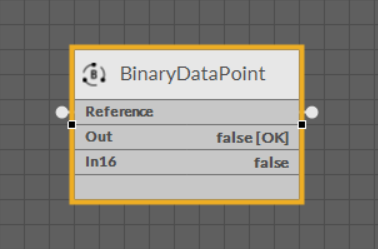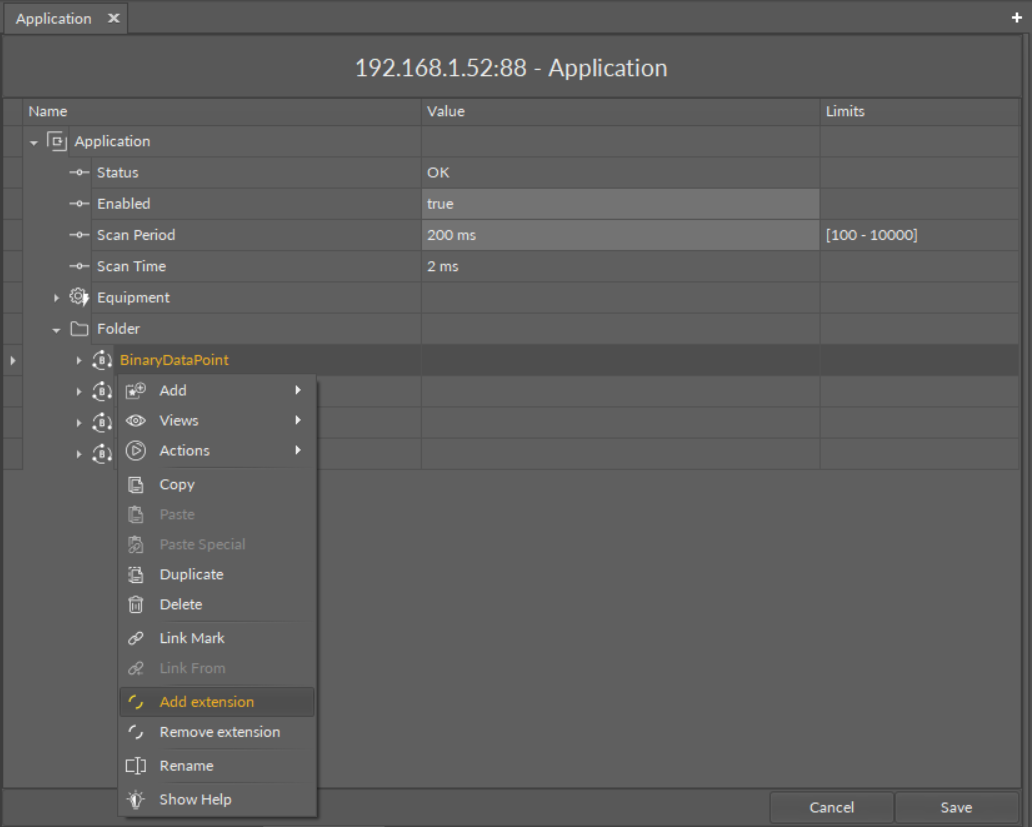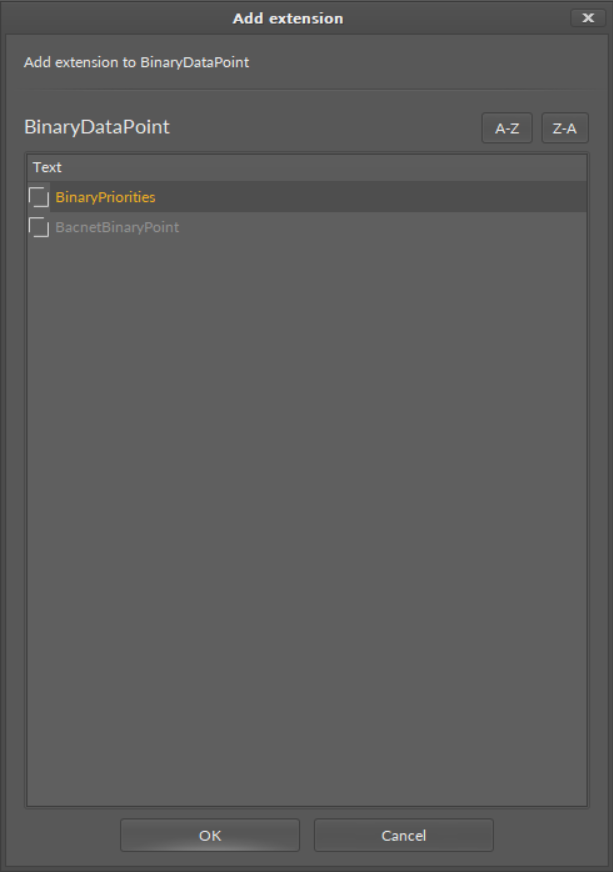Applicable to library's version 1.0
The Binary Data Point component is a component that represents a Boolean value in the application; it reads binary values calculated in applications and controls local or remote binary outputs. The Binary Data Point allows to create standard links to all inputs and outputs; it may transfer a value via a link from the Out slot to other components. The other method to link the Binary Data Point is via a Reference link. The Reference link is a special compound link designed to connect Data Points with network points. The Reference link is created between special Reference slots in network points and transfers values along with the its status to Binary Data Points. Also, it may transfer values from Binary Data Points to network points at the same time returning status from network points to Binary Data Points, and it may return values from network points to Binary Data Points too. While linking Data Points and network points it is recommended to use the Reference linking method.
In order to operate properly, the component must be placed in the Application component in the Applications container.

Binary Data Point
The Binary Data Point can operate in two modes. First, it is a basic mode with one writable input slot (In16), one output slot (Out), Reference linking, and other basic slots: Active Text, Inactive Text, Status, Enabled, Description. In the basic mode, the BACnet Data Point has a native BACnetBinaryPoint extension.

The Binary Data Point component in simple variant
In its basic mode, the Binary Data Point has one action: Set (which allows to set a value to the In16 slot).
The Binary Data Point has the following basic slots:
-
Status: indicates the current status of the component. If the component works properly, its status is OK; however, it changes accordingly when values in other slots are adjusted;Available information: Disabled, Unlicensed, Error, Overriden, OK;
Note: If the referenced network point goes into a high priority status (e.g., fault or down), the Data Point's status will show Error in order to communicate that the value in the Out slot may be invalid.
-
Reference: a special slot allowing to transfer more than one value with one link (e.g., the Out slot value and the component's Status); connects Data Points with network point class components;
Note: The Data Point allows to create only one Reference connection leading to it and many Reference connections leading from it.
-
Description: an additional detailed information about a component that may be freely described by the user; the description may contain individual coding defined in the user's system documentation or any other information the user finds applicable;
-
Enabled: change of the slot's value enables or disables the component–if the component becomes disabled, it stops reading values from or transferring values to the linked Network Points. By default, the component is enabled;Available settings: true (enabled), false (disabled);
-
Out: shows a value of the first non-null input with highest priority; in case there are values on different priorities, only the value from the highest priority slot is transferred to the Out slot, the rest is dismissed;
Note: In the Wire Sheet, the Out slot is visible as combined slots Out, Priority, and Status. The Out slot displays the value in accordance with the settings in the ActiveText and InactiveText slots.
-
InactiveText: a text value that is displayed in the Out slot if its value is false; the text is freely adjustable by the user. By default, this field is empty and "false" is displayed for a false value;
-
ActiveText: a text value that is displayed in the Out slot if its value is true; the text is freely adjustable by the user. By default, this field is empty and "true" is displayed for a true value;
-
In16: the basic input slot; receives Boolean values; the In16 value may be set by a Set action.
The Binary Data Point has one basic action:
-
Set: allows entering a Boolean value to set the In16 slot;
-
SetId: sets a BACnet object Id of the Binary Data Point.
The extended mode of the Binary Data Point is switched on by adding the BinaryPriorites extension to the Binary Data Point component. The extension adds 16 writable input slots to the Data Point. It is added by right-clicking on the Binary Data Point component (either in the Wire Sheet or Property Sheet view, Application Manager, or the Workspace Tree).
Extensions
Data Points can have their functionality modified by extensions. The Binary Data Point is originally equipped with the BACnet Binary Point extension (this one cannot be added or removed), but other extensions, which offer different functionalities, can be added or removed as necessary. Extensions are added by right-clicking the Binary Data Point, either in the Wire Sheet or Property Sheet view, Application Manager, or the Workspace Tree.

Adding extension in the Wire Sheet view

Adding extension in the Property Sheet view
From the context menu, select the Add extension option. The pop-up window appears allowing to choose an extension to add.

Adding extension dialog window
BACnetBinaryPoint Extension
The BACnetBinaryPoint extension expands the Binary Data Point's functionality giving it an option to expose it to the BACnet network as a Binary Value object, and otherwise, it allows to manually hide it from the network yet preserving its function in the application. It also transfers information to the BACnet network about the Binary Data Point's. The extension is native (cannot be removed), and is visible along with the regular slots and actions of the Binary Data Point as a separate, integral part in the Object Properties view.
The extension has the following slots:
-
Object: a read-only slot showing a type of BACnet object attributed to the extension;
-
ObjectID: a BACnet object ID, which is automatically numbered from 0 up;
-
Expose: enables the Data Point to be recognized within the BACnet network;Available settings: true (exposed), false (hidden).
BACnetPriorities Extension
The BinaryPriorites extension adds In1–In15 slots and the Default slot, which is the lowest, 17th priority. The extension also introduces new actions to the Data Point: EmergencyOverride, EmergencyAuto, Override, and OverrideAuto. The BinaryPriorities extension adds fifteen writable input slots and the default priority slot to the Binary Data Point. The extension includes also the Priority slot indicating, which slot is transferring value to the Out slot.

The extended variant of the Binary Data Point
The Binary Data Point has the following slots available in the BinaryPriorities extension:
-
In1–In15: input slots providing values to the Out slot (from 1 to 16, the highest priority is In1); only the highest priority value is provided to the Out slot, the rest is dismissed. All input slots are linkable. The In1 and In8 slots have actions available for emergency overriding their values;
Note: By default, only In16 is displayed in the Wire Sheet. In case any other input slot receives a value via link, is it displayed in the Wire Sheet along with the In16. Only the null value allows the higher priority input to be dismissed.
-
Default: the 17th, lowest priority input slot; allows to introduce a default value to the Data Point in case there are no links providing values from other components. If the value to the Data Point is provided by the Reference link, then the Default value is automatically dismissed (the Reference link cannot be directed to the 17th priority, only from the 16th up).
Note: According to BACnet requirements, the Default slot value can never be null; if no other value is set on the slot, it is false.
-
Priority: shows which slot is currently providing the value to the Out slot.
The Binary Data Point has the following actions available in the BinaryPriorities extension:
-
EmergencyOverrideActive: enables entering a true value to the In1 slot;
-
EmergencyOverrideInactive: enables entering a false value to the In1 slot;
-
EmergencyAuto: sets the null value to the In1 slot (cancels the EmergencyOverrideActive and EmergencyOverrideInactive action);
-
OverrideActive: enables entering a true value to the In8 slot;
-
OverrideInactive: enables entering a false value to the In8 slot;
-
OverrideAuto: sets the null value to the In8 slot (cancels the OverrideActive and OverrideInactive actions).
